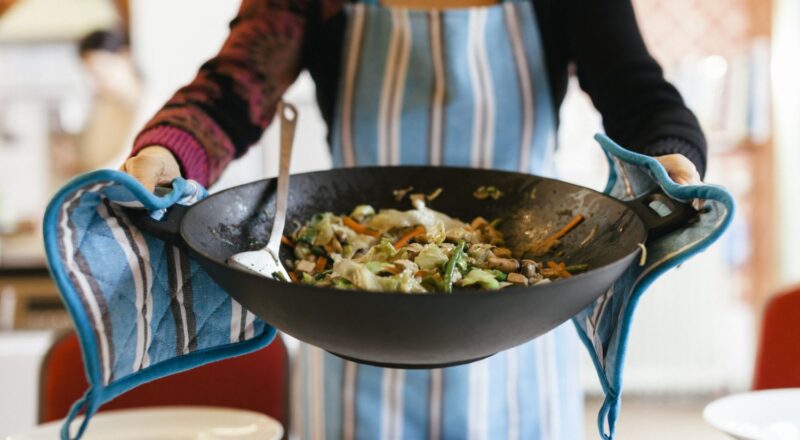Cooking enthusiasts and kitchen professionals alike often seek advice on how to season an aluminum wok. Whether you’re a seasoned chef or a home cook aiming to perfect your culinary skills, seasoning your wok properly can make a remarkable difference. It not only enhances the wok’s performance but also extends its life, making it a valuable investment in your kitchen. Embrace the tradition and technology of wok seasoning with us today, as we explore the steps in this life-changing guide, turning your ordinary cooking experiences into tremendous ones!

The Remarkable Benefits of Seasoning an Aluminum Wok
Many people overlook the significance of the seasoning process. Properly seasoning your wok can transform your cooking experiences in numerous ways. Not only does it create a natural non-stick surface, reducing the need for excessive oils, but it also imparts a unique flavor to your dishesa terrific advantage for those who delight in spicy stir-fries or delicate vegetables.
Creating a Natural Non-Stick Surface
Seasoning builds a slick coating on the woks surface, preventing food from sticking and burning during cooking. This exclusive layer allows for easier cleaning and reduces the need for cooking oil, contributing to healthier meal preparation.
Adding Depth to Flavors
The process of seasoning your wok enhances the flavors of your food. Each time you cook, the oils used react with the heat, forming a layer that imparts a subtle yet complex flavor profile to your dishes. It’s here where traditional techniques combine with modern technology to enhance your dishes’ taste without overpowering them.
Essential Equipment for Seasoning
Before diving into the seasoning process, gather these necessary tools:
- Aluminum Wok
- Stovetop or other heat source
- Cooking oil (such as vegetable or flaxseed oil)
- Bamboo brush or sponge
- Heat-safe gloves
Having your equipment ready ensures a smooth, efficient seasoning process.
Step-by-Step Guide: How to Season an Aluminum Wok
Step 1: Clean Your Wok
Begin by washing the wok thoroughly to remove any factory-applied oils. Use warm water, mild detergent, and a gentle sponge. Rinse thoroughly to eliminate any soap residue. This initial cleaning step prepares the surface by removing contaminants, setting the stage for effective seasoning.
Step 2: Dry the Wok Completely
Heat the cleaned wok over a medium flame until completely dry. This process eliminates moisture that could disrupt the even application of the oil during the next step. Be cautious not to overheat; you should achieve dryness without discoloring the metal.
Step 3: Apply Oil
Once cooled, apply a small amount of oil onto the woks surface. Use a cloth to distribute the oil evenly, covering the entire inner surface. Choose your oil wisely; flaxseed is recommended for strong, durable seasoning.
Step 4: Heat the Wok on Stovetop
Return the oiled wok to the heat source, gradually increasing the temperature. Heat until the oil begins to smoke, then reduce the temperature, maintaining a steady heat. Continue this process for 15 to 20 minutes, allowing time for the oil to polymerize and create a bonding layer, key for shockingly effective seasoning.
Repeat as Necessary
For the best finish, repeat the heating and oiling process 2 to 3 times. Each round enhances the wok’s surface, resulting in superior non-stick performance and flavor enhancement, such that your cooking technique is sharply approved by culinary experts.
Maintaining a Seasoned Wok
Protect and maintain the integrity of your wok’s seasoning by considering the following steps after each use:
Avoid Harsh Detergents
Use warm water with a bamboo brush for cleaning. Avoid detergents as they strip away seasoned layers, undermining all your hard work.
Regular Usage
Frequent cooking helps maintain your woks seasoned surface, keeping it active through cycles of cooking with high heat and oils.
For those wanting to explore the unique features of a wok, learn about [Wok Usage](https://howtocleancastiron.com/how-to-use-wok/) efficiently.
Troubleshooting: What if My Wok Doesn’t Season Properly?
Even with the best intentions, things may not always go as planned. If your wok doesnt achieve a proper seasoning layer or if food sticks, you may need to repeat the heating process and reapply oil. Inspect the surface for uneven oil layers or cooking residues, and then proceed accordingly.
Understanding Wok Characteristics
Aluminum woks respond differently compared to their carbon steel counterparts. Due to their unique metal properties, seasoning might involve more nuanced steps than typical. Refer to this guide for a deeper understanding.
Preparing for Lifelong Culinary Adventures
Arming yourself with the knowledge to season an aluminum wok prepares you for a culinary journey filled with delicious surprises and remarkable success. No chef should be without the classic proficiency that comes from a well-used, well-cared-for wok. As you venture into vegetable wonders or exploring vibrant techniques with this innovative guide, let your seasoned wok be the foundation of your adventures.

FAQ
Why do I need to season an aluminum wok?
Seasoning creates a natural non-stick surface, preventing food from sticking and burning. It also develops a unique flavor over time, enriching your dishes with depth.
What type of oil is best for seasoning?
Flaxseed oil is highly recommended for its ability to form a durable, polymerized layer. Vegetable oil is equally effective due to its high smoke point.
Can I season with zero oil?
No, oil is necessary for polymerization. Dry heating cannot create the bonding needed for the protective non-stick layer.
As an Amazon Associate, I earn from qualifying purchases.

